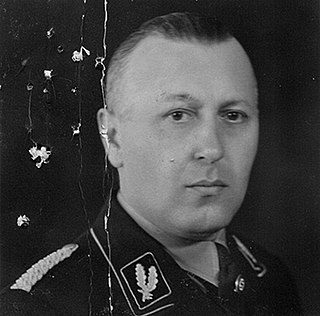
Ernst Kaltenbrunner was a high-ranking Austrian SS official during the Nazi era and a major perpetrator of the Holocaust. After the assassination of Reinhard Heydrich in 1942, and a brief period under Heinrich Himmler, Kaltenbrunner was the third Chief of the Reich Security Main Office (RSHA), which included the offices of Gestapo, Kripo and SD, from January 1943 until the end of World War II in Europe.

The Geheime Staatspolizei, abbreviated Gestapo, was the official secret police of Nazi Germany and in German-occupied Europe.

Reinhard Tristan Eugen Heydrich was a high-ranking German SS and police official during the Nazi era and a principal architect of the Holocaust.

Aktion T4 was a campaign of mass murder by involuntary euthanasia in Nazi Germany. The term was first used in post-war trials against doctors who had been involved in the killings. The name T4 is an abbreviation of Tiergartenstraße 4, a street address of the Chancellery department set up in early 1940, in the Berlin borough of Tiergarten, which recruited and paid personnel associated with Aktion T4. Certain German physicians were authorised to select patients "deemed incurably sick, after most critical medical examination" and then administer to them a "mercy death". In October 1939, Adolf Hitler signed a "euthanasia note", backdated to 1 September 1939, which authorised his physician Karl Brandt and Reichsleiter Philipp Bouhler to begin the killing.

The Reich Security Main Office was an organization under Heinrich Himmler in his dual capacity as Chef der Deutschen Polizei and Reichsführer-SS, the head of the Nazi Party's Schutzstaffel (SS). The organization's stated duty was to fight all "enemies of the Reich" inside and outside the borders of Nazi Germany.

Odilo Lothar Ludwig Globocnik was a Nazi Party official from Austria and a perpetrator of the Holocaust. A high-ranking leader of the SS, Globocnik played a leading role in Operation Reinhard, the organized murder of around one and a half million Jews, mostly of Polish origin, during the Holocaust in the Majdanek, Treblinka, Sobibór and Bełżec extermination camps. Historian Michael Allen described him as "the vilest individual in the vilest organization ever known". Globocnik killed himself shortly after his capture and detention by British soldiers.

Obergruppenführer was a paramilitary rank in Nazi Germany that was first created in 1932 as a rank of the Sturmabteilung (SA) and adopted by the Schutzstaffel (SS) one year later. Until April 1942, it was the highest commissioned SS rank after only Reichsführer-SS. Translated as "senior group leader", the rank of Obergruppenführer was senior to Gruppenführer. A similarly named rank of Untergruppenführer existed in the SA from 1929 to 1930 and as a title until 1933. In April 1942, the new rank of SS-Oberst-Gruppenführer was created which was above Obergruppenführer and below Reichsführer-SS.

Karl Friedrich Otto Wolff was a German SS functionary who served as Chief of Personal Staff Reichsführer-SS and an SS liaison to Adolf Hitler during World War II. He ended the war as the Supreme SS and Police Leader in occupied Italy and helped arrange for the early surrender of Axis forces in that theatre, effectively ending the war there several days sooner than in the rest of Europe. He escaped prosecution at the Nuremberg Trials, apparently as a result of his participation in Operation Sunrise. In 1962, Wolff was re-arrested and prosecuted in West Germany for the deportation of Polish Jews, and he was sentenced to 15 years in prison for being an accessory to murder in 1964. He was released in 1971 due to his failing health, and died 13 years later.

Kurt Max Franz Daluege was a German SS and police official who served as chief of Ordnungspolizei of Nazi Germany from 1936 to 1943, as well as the Deputy/Acting Protector of Bohemia and Moravia from 1942 to 1943.

Hans Heinrich Lammers was a German jurist and prominent Nazi Party politician. From 1933 until 1945 he served as Chief of the Reich Chancellery under Adolf Hitler. In 1937, he additionally was given the post of Reichsminister in the cabinet. During the 1948–1949 Ministries Trial, Lammers was found guilty of crimes against peace, war crimes, crimes against humanity, and membership in a criminal organization. He was sentenced to 20 years in prison in April 1949 but this was later reduced to 10 years and he was released early.

The government of Nazi Germany was a totalitarian dictatorship governed by Adolf Hitler and the Nazi Party according to the Führerprinzip. Nazi Germany was established in January 1933 with the appointment of Adolf Hitler as Chancellor of Germany, followed by suspension of basic rights with the Reichstag Fire Decree and the Enabling Act which gave Hitler's regime the power to pass and enforce laws without the involvement of the Reichstag or German president, and de facto ended with Germany's surrender in World War II on 8 May 1945 and de jure ended with the Berlin Declaration on 5 June 1945.

The Deutschvölkischer Schutz- und Trutzbund was the largest and the most active antisemitic federation in Germany after the First World War, and an organisation that formed a significant part of the völkisch movement during the Weimar Republic (1918–1933), whose democratic parliamentary system it unilaterally rejected. Its publishing arm issued books that greatly influenced the opinions of Nazi Party leaders such as Heinrich Himmler. After the organisation folded in around 1924, many of its members eventually joined the Nazis.

Wilhelm Karl Keppler was a German businessman and one of Adolf Hitler's early financial backers. Introduced to Hitler by Heinrich Himmler, Keppler helped to finance the Nazi Party and later served as one of Hitler's economic advisors.

Josef Fitzthum was a high-ranking Austrian member of the SS and Special Representative of the Reichsführer-SS in Albania during World War II.

Lina Mathilde Manninen was the wife of Reinhard Heydrich, head of the Reich Security Main Office and a central figure in Nazi Germany. The daughter of a minor German aristocrat, she joined the Nazi Party in 1929 and met Reinhard Heydrich in December 1930. The two wed on 26 December 1931 and had four children. After World War II ended, she published a memoir in 1976. She spoke with several authors, wrote letters of correction to many newspapers, and defended the reputation of her first husband (Heydrich) until her death at age 74 in August 1985 in Fehmarn.

Ernst-Heinrich Schmauser was a German Nazi Reichstag deputy and SS-Obergruppenführer who was the Higher SS and Police Leader (HSSPF) in Breslau during World War II. He was responsible for the death march from Auschwitz–Birkenau concentration camp, in which upwards of 25 percent of the prisoners were killed. In the last months of the war, he was captured by the Red Army and presumed killed.














